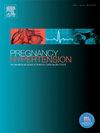Home blood pressure monitoring and mobile health application practices among pregnant persons with and at risk of hypertensive disorders of pregnancy
IF 2.9
4区 医学
Q2 OBSTETRICS & GYNECOLOGY
Pregnancy Hypertension-An International Journal of Womens Cardiovascular Health
Pub Date : 2025-01-31
DOI:10.1016/j.preghy.2025.101197
引用次数: 0
Abstract
Objectives
To examine training in and current home blood pressure monitoring (HBPM) practices in pregnancies with hypertensive disorders of pregnancy (HDP) or risk factors for HDP; and to explore interest in using mHealth applications for communicating with healthcare providers.
Study design
A cross-sectional survey was conducted on HBPM practices/training and interest in using mobile health (mHealth) applications among pregnant persons at an academic medical center.
Outcome measures
The main outcomes measured were the proportion of participants who received training for HBPM, and the proportion interested in using mHealth applications for communication with providers related to managing HDP.
Results
Of the 103 participants, 41 (39.8%) used HBPM. Of those who did HBPM, 36.6% received training from their healthcare providers. Training more often included instructions on positioning and how to perform HBPM, and rarely included advice on validated HBPM devices. Nearly all participants (98.1%) owned a smartphone, and 19.4% had a smartwatch. A significant majority expressed interest in using a secure mobile app for communication with providers (78.6%), and 88.3% were interested in wearing a smartwatch for remote monitoring. There were no significant differences in interest levels based on race, age, residence, or education, while there was higher interest (100% vs. 67%) in mobile apps for communication among those with HDP vs. risk factors for HDP.
Conclusions
Despite a low level of training for HBPM, there was high interest in using mHealth applications. Leveraging mHealth technology could help overcome the challenges of providing training for HBPM.
在患有和有妊娠高血压疾病风险的孕妇中进行家庭血压监测和移动保健应用实践。
目的:探讨妊娠期高血压疾病(HDP)或HDP危险因素的培训和当前家庭血压监测(HBPM)实践;探索使用移动医疗应用程序与医疗保健提供者沟通的兴趣。研究设计:对一家学术医疗中心孕妇中HBPM实践/培训和使用移动医疗(mHealth)应用程序的兴趣进行了横断面调查。结果测量:测量的主要结果是接受HBPM培训的参与者的比例,以及有兴趣使用移动健康应用程序与管理HDP相关的提供者进行通信的比例。结果:103名参与者中,41名(39.8%)使用HBPM。在进行HBPM的人中,36.6%的人接受了医疗保健提供者的培训。培训更多的是关于定位和如何执行HBPM的指导,很少包括对经过验证的HBPM设备的建议。几乎所有参与者(98.1%)都拥有智能手机,19.4%拥有智能手表。绝大多数人表示有兴趣使用安全的移动应用程序与供应商进行通信(78.6%),88.3%的人对佩戴智能手表进行远程监控感兴趣。基于种族、年龄、居住地或教育程度的兴趣水平没有显著差异,而HDP患者与HDP危险因素相比,对移动应用程序进行交流的兴趣更高(100% vs 67%)。结论:尽管HBPM培训水平较低,但人们对使用移动健康应用程序很感兴趣。利用移动医疗技术可以帮助克服为HBPM提供培训的挑战。
本文章由计算机程序翻译,如有差异,请以英文原文为准。
求助全文
约1分钟内获得全文
求助全文
来源期刊

Pregnancy Hypertension-An International Journal of Womens Cardiovascular Health
OBSTETRICS & GYNECOLOGYPERIPHERAL VASCULAR-PERIPHERAL VASCULAR DISEASE
CiteScore
4.90
自引率
0.00%
发文量
127
期刊介绍:
Pregnancy Hypertension: An International Journal of Women''s Cardiovascular Health aims to stimulate research in the field of hypertension in pregnancy, disseminate the useful results of such research, and advance education in the field.
We publish articles pertaining to human and animal blood pressure during gestation, hypertension during gestation including physiology of circulatory control, pathophysiology, methodology, therapy or any other material relevant to the relationship between elevated blood pressure and pregnancy. The subtitle reflects the wider aspects of studying hypertension in pregnancy thus we also publish articles on in utero programming, nutrition, long term effects of hypertension in pregnancy on cardiovascular health and other research that helps our understanding of the etiology or consequences of hypertension in pregnancy. Case reports are not published unless of exceptional/outstanding importance to the field.
 求助内容:
求助内容: 应助结果提醒方式:
应助结果提醒方式:


